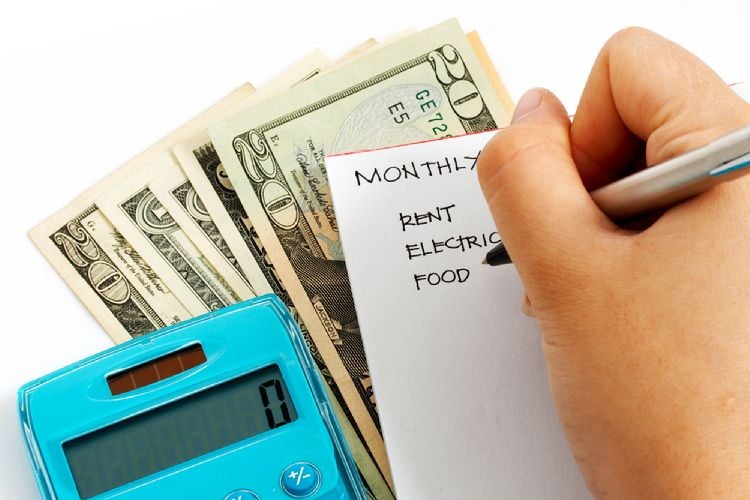There is no minimum income required to buy a car if you save up and pay cash. Financing, on the other hand, has many requirements, including income. Your credit plays a large part in what type of loan you qualify for and how much income you’re required to have. You can typically expect to need a minimum income of $1,500 to $2,500 a month in order to get approved for a bad credit car loan, but this isn't the only income requirement to be aware of.
Financing with Good Credit
When you have good credit (a FICO score of 670 or higher), the process of buying or financing a vehicle can be relatively simple. Ideally, you pick out a vehicle, get financing, go to a dealer, sign your paperwork, and take delivery of your new car. It’s a very basic process when you’re not worried about your credit standing in the way. The lender will do some calculations to make sure you can afford the payment, but if you have good credit, your income doesn’t matter as much, and you’ll have less to prove than if you have bad credit.
Minimum Income for a Car Loan
Bad credit auto lenders use your income as a major factor when you apply for a car loan. As a way of verifying you make enough to afford a car payment, subprime lenders require a certain minimum income. In our experience, the minimum income requirement typically ranges from $1,500 to $2,500 a month before taxes. Granted, this varies from lender to lender and there may even be programs with lower income requirements.
There are a few other things to keep in mind when it comes to your income:
- Lenders look at your gross income, or what you make before taxes and deductions get taken out.
- Lenders want to see W-2 income, so being self-employed or making unearned income introduces a different set of rules to qualify.
- You have to meet the minimum income amount with earnings from a single job – you can't combine earnings from a second or third job or additional sources of income.
- Bad credit lenders require proof of income, typically with a computer-generated pay stub that lists your year-to-date earnings from the past 30 days, or multiple years of tax returns if you're not a W-2 employee.
Because of our experience with subprime auto loans, we know that income is one of the biggest determining factors for subprime lenders during the loan decision. Most require that an applicant has a minimum monthly income of $1,500-1,800 gross (pre-tax) in order to qualify.

But we also want to express that lending is done on a case-by-case basis. Each applicant is evaluated individually. Nowhere is this more evident than when dealing with income situations.
There are a lot of extenuating circumstances and factors that can sway a loan decision. It's actually possible for an applicant making $1,800 a month to be viewed more favorably than another one who has a monthly income of $3,000.
How is that possible, you ask? When it comes to subprime lending, qualifying income is about much more than the amount of money you take home. It has a lot to do with what you are spending or your monthly recurring debt.
Other Car Loan Income Requirements
Subprime lenders do have minimum income requirements, but they will also calculate two important ratios that are going to tell them more about your income situation. In addition to a certain level of income, subprime lenders require you to meet their debt-to-income and payment-to-income ratio requirements. These two lesser-known income requirements help make sure a car payment fits into your budget.
Lenders do not want your potential car payment and insurance payment to eat up too much of your gross monthly income, which is where your payment to income ratio comes into play. They will add up an estimated car and insurance payment and divide that number by your monthly pre-tax income. Subprime lenders do not want an applicant's PTI ratio to exceed 15-20% of their take home pay.
They will also be sure to calculate your debt to income ratio. To calculate your DTI, they add up your monthly expenses and divide that number by your gross monthly income. Subprime lenders will even add an estimated car and insurance payment to your monthly expenses and see how that changes your DTI ratio. The general rule is that auto lenders do not want your DTI ratio to top 50% of your pre-tax income.
Debt to Income Ratio
The debt to income (DTI) ratio calculates how much of your income is dedicated to your monthly bills. Subprime lenders typically require that your DTI ratio isn't higher than 50% of your gross monthly income (though this will vary by lender). Because lenders are going to do it the second they get your application, it makes sense for you to calculate your DTI ratio as you prepare for your auto loan.
To find it, add up all of your monthly bills, including your rent or mortgage payments, other loan payments, minimum credit card payments, and any other recurring payments that show up on your credit reports. Next, divide that total by your gross monthly income to get your DTI ratio.
For example, if you made $3,000 a month gross and your monthly bills added up to $1,100, you would divide 1,100 by 3,000 and get 0.366, or 36.6 percent. This would fall into the acceptable DTI range for almost all subprime lenders. However, keep in mind that they also factor a car payment and insurance payment into your DTI and still want it below 50 percent.
Payment to Income Ratio
A second calculation lenders use is the payment-to-income (PTI) ratio, which can be found by dividing your combined car and insurance payment by your pre-tax monthly income. Subprime lenders usually set a maximum PTI of 15% to 20%, though it again can vary. Simply put, lenders don't want these expenses to eat up too much of your total income to make sure you can afford the vehicle.
You can calculate your PTI ratio, but you'll have to estimate the car and insurance payments. This can give you a better idea of the price range of vehicles you should be looking at.
Bad Credit Auto Financing
With bad credit, the requirements for financing are different than with good credit and you have to meet all lender qualifications, including minimum income, to buy a car. A lender needs to be confident you can complete the loan without struggling to make payments. Lenders set income requirements as well as minimum DTI and PTI ratios to make sure you can do this.
Having more than one income can help with DTI and PTI ratios, however. Even though a second job won't help you meet the minimum income requirement, your additional income can be added to your main income when you calculate your DTI and PTI ratios.
Finding Financing for Your Situation
No matter what your situation is, it’s a good idea to know where your credit stands, and to prepare a budget to ensure you can comfortably afford a loan. There are many tools available online that can help DTI and PTI calculations, as well as car loan estimators that can give you a sense of what overall monthly payments you might qualify for.
If you’re struggling with credit issues and don’t know where to turn for an auto loan, Auto Credit Express can help. We work with a coast-to-coast network of special finance dealers that have lending resources to work with people in many difficult situations. Fill out our free, no-obligation auto loan request form online to start the process of finding auto financing now!



















